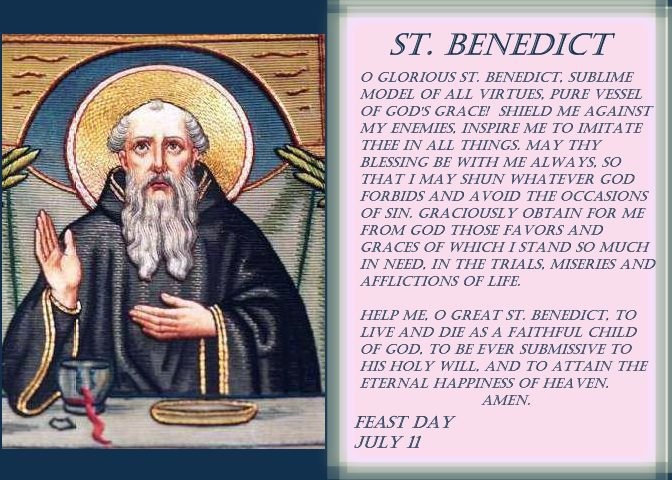 Saint Benedict of Norcia (480-543) Image: Pinterest
Saint Benedict of Norcia (480-543) Image: Pinterest
(CNA) Born into the Nobility of Italy Rome, there is not much known of Benedict’s early childhood — In 2008 Pope Benedict XVI speaking of St. Benedict said:
“…Young Benedict was put off by the dissolute lifestyle of many of his fellow students and did not wish to make the same mistakes — he wanted only to please God…Thus even before he finished his studies, Benedict left Rome and with drew to the solitude of the mountains east of Rome. After a short stay in the village of Enfide (now Affile) where for a time he lived with a ‘religious community’ of Monks (and) he became a Hermit in the neighboring locality of Subiaco.”
There Benedict spent three years in solitude with God which was a time of maturity to him, facing and overcoming three fundamental temptations of every human being:
- (1) the temptation of self affirmation–putting oneself at the center of everyone else;
- (2) the temptation of sensuality;
- (3) the temptation of anger and revenge.
Pope Emeritus Benedict said, “In fact, Benedict was convinced that only after overcoming these temptations would he be able to say a useful word to others about their own situations of neediness. Thus having tranquilized his soul, he could be in full control of the drive of his ego and thus create peace around him. Only then did he decide to found his first Monasteries in the Valley of Anio, near Subiaco.”
Benedict’s Monasteries became centers of education for children, in tradition which would continue in the order during his lifetime and beyond. — Benedict’s monastic movement like its forebears in the Christian East, attracted large numbers of people who were looking to live their Christian faith more deeply.
During 529 Benedict left Subiaco for Monte Cassino (about 80 miles South of Rome) this move was geographically and spiritually significant, making a more public emergence of the Western Monastic movement. Benedict destroyed a Pagan Temple atop a mountain and constructed two Oratories in its place.
It was most likely at Monte Cassino that Benedict drew up a Rule for Life (known as the famous ‘Rule of St. Benedict’ which emphasized prayer, work, simplicity and hospitality–though known as a ‘Rule for Monks’ it is addressed to all those who seek ‘to do battle for Christ the Lord, the true King.’
Saint Benedict’s life was marked by various intrigues and miraculous incidents which are described in his biography, written by Pope Saint Gregory the Great — One of the most remarkable was Benedict’s meeting in 543 King Totila of the Goths, in which he rebuked the king’s lifestyle and prophesied his death.
Saint Scholastica (Feast Day: 10 February) Benedict’s sister also embraced a religious life as a Nun, she likely died just before or after her brother Saint Benedict. During his final years, it is reported that he had a profound mystical experience, which is said to have involved a supernatural vision of God and the whole of creation.
Around the age of 63 Benedict became ill, he was carried into the Church at Monte Cassino by his fellow Monks, where he received the Eucharist for the final time–Held up by his disciples, he raised up his hands in prayer before dying in their arms.
Benedict was Canonized in 1220 by Pope Honorius III
More here from Franciscan Media
Related: For Today’s Holy Scripture Readings for the Memorial of St. Benedict, Visit: -USCCB